Top News
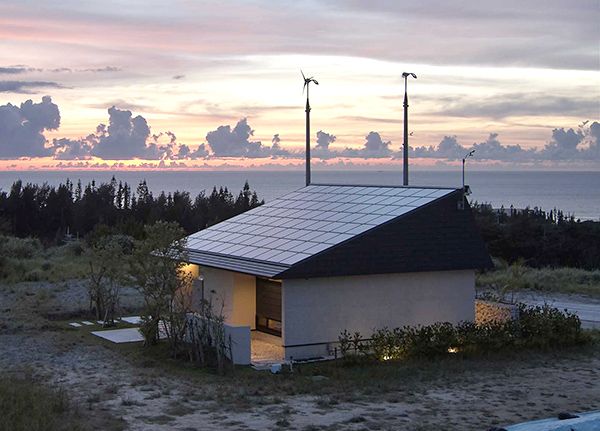
October 3, 2019 Ryukyu Shimpo
On October 2 the Japan Institute of Design Promotion (Tokyo Prefecture) announced the results of the 2019 Good Design Award (1,420 entries selected).
The Okinawa Institute of Science and Technology Graduate University (OIST, Onna Village) and Misawa Homes Institute of Research and Development (MHIRD, Tokyo Prefecture), among others, conducted collaborative research on creating a stand-alone house that generates energy and water, and that coexists with and reduces the burden on the environment.
This Sustainable Architecture in the Hot-Humid Region (hereafter referred to as Sustainable Architecture) was assessed to be useful as a model for the future, and was selected for the special award “Best 100”.
This is the first time since Best 100 announcements began in 2012 that an entry from Okinawa has been selected for it.
Stone walls and such of the Sustainable Architecture are built of Ryukyu Limestone, in part by adopting traditional methods, such that the Sustainable Architecture is resistant to strong sunlight and typhoons, and serves the purposes of equipment for accumulating solar heat, sunlight, and rain water.
The research was pursued at OIST, which is in a subtropical, hot, and humid region, for the purpose of development in developing island nations such as Indonesia.
Professor Hiroaki Kitano, a researcher representing OIST, said, “Okinawa is the best region for conducting this research in terms of being hot, having high humidity, and there being damage from salt.
The design has been assessed to be very important in that is has vast significance and can potentially demonstrate considerably high-quality results.
From here on we will advance discussions toward making practical use [of the design].”
OIST, Sony Computer Science Research Laboratories (Tokyo), and Misawa Homes (Tokyo) were jointly granted the award for the Sustainable Architecture.
Aside from the Sustainable Architecture, the House on the East Coastline from Atelier Kadoguchi Co. Ltd. (Uruma City, representative Yasunori Kadoguchi), and the Ideal Currency Myahk from Institute Rito Mirai Lab (Miyako City) and Suisei Inc. (Tokyo) were also selected for the Good Design Award.
(English translation by T&CT and Erin Jones)
Go To Japanese

September 19, 2019 Ryukyu Shimpo
The “2019 Asia Cruise Forum Jeju,” an annual forum meant to stimulate the Asian cruise market, took place from August 28-30 on Jeju Island, Korea, where Okinawa was selected as the top port of call in Asia. The number of ports, Okinawa’s nature and culture, superior geographic location, and speedy CIQ (Customs, Immigration, and Quarantine) process, among other factors contributed to their overall high rating. This is the second time Okinawa has won the award since 2017.
The award ceremony was held August 28, and was attended by Akio Kijihana, head of the Okinawa Department of Culture, Tourism, and Sports’ Tourism Promotion office.
The Asia Cruise Forum Jeju gathers people from the cruise industry in the Asian region in order to exchange ideas and find areas of cooperation. The goal is to grow the overall cruise market in Asia.
Kenichi Arakaki, head of the Okinawa Culture, Tourism, and Sports Department said, “We want to continue to work diligently at promoting cruises.”
(English translation by T&CT and Sam Grieb)
Go to Japanese
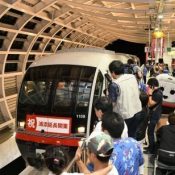
October 1, 2019 Ryukyu Shimpo
Okinawa Urban Monorail, also known as Yui Rail, expanded its existing line 4.1km into Urasoe City. Service to the extended line began on September 29. Four new stations service the extended zone: Tedako-Uranishi, Urasoe-Maeda, Kyōzuka and Ishimine, which opened its doors at 5:15 a.m. The first monorail departed Tedako-Uranishi station at 5:39 a.m., where commemorative postcards were given away. Tedako-Uranishi station and Ishimine station were both packed with patrons despite the early morning hours.
Okinawa Urban Monorail Inc. CEO Yoshimasa Misato delivered a speech at the opening ceremony at Tedako-Uranishi station: “This extension of the Yui Rail and its service will provide Urasoe City with a mode of transportation that is on-time, consistent, safe and comfortable, which will significantly change the lifestyles of Urasoe residents. I expect it will thrust forward the development of nearby neighborhoods. In particular, Tedako-Uranishi station has great potential to become a transportation hub, as it offers connections to the central-northern areas of the island. Tedako-Uranishi will become a key area for Okinawa, as locals and tourists pass through this station during their travels.” The CEO added, “Yui Rail is a transportation system that is people-friendly. We connect people to towns, and people with people. We will continue our contribution in developing the areas surrounding Urasoe station.”
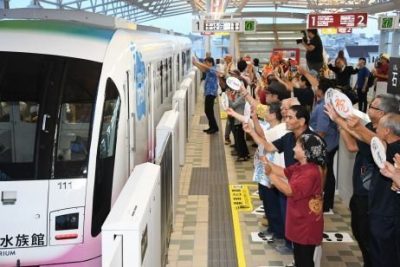
Local residents pleased with the Urasoe expansion gather at Ishimine station in Naha City to send off the 6:30 a.m. train.
First in line at Tedako-Uranishi station on opening day was a Naha City resident, Isamu Yamakawa, 55. Yamakawa was one of the first passengers of the Yui Rail, and took the inaugural train from Shuri station at the grand opening in 2003. Determined to be the first passenger of the extended line, Yamakawa arrived at Tedako-Uranishi station at 4:30 a.m. to wait for its doors to open. When asked why, he replied: “Because it’s there.”
During the 7:30 through 8:30 morning rush hour, the platforms and trains were flooded with commuters. Okinawa Urban Monorail had revised the schedule for opening day, and extended the rush hour window in which trains run every four minutes. Nonetheless, some commuters at Omoromachi station were forced to wait for the next ride, as they were unable to board the overflowing cars.
Naha City office worker Nanako Taira, 31, observed the Naha Airport-bound 8:20 train as it arrived the station and said, “It’s crowded more than usual, maybe because they extended the line into Urasoe City.” She boarded the next train.
Yui Rail debuted in 2003; The extension brings the line to a total of 17km in length, and 19 stations.
(English translation by T&CT and Monica Shingaki)
Go To Japanese
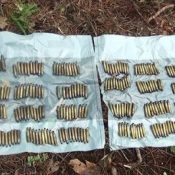
September 30, 2019 Ryukyu Shimpo
(Kunigami) On September 28, 342 unused U.S. military bullets and a large quantity of field ration packaging and other garbage were discovered near the location of the former LZ-1 helipad on returned land that used to be part of the U.S. military’s Northern Training Area in Ada, Kunigami, Okinawa. Butterfly researcher Akino Miyagi made the discovery, and the munitions and garbage were collected by Nago police workers on September 29. From the state of the garbage, it appeared to have been disposed of very recently, indicating the possibility that the U.S. military is still using said land even after its return. On September 19, 463 pieces of unused and unexploded munitions were found near the location of the former LZ-FBJ helipad on returned land also in Ada, Kunigami.
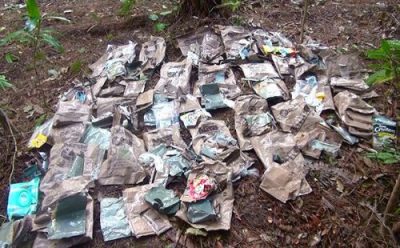
Field ration packaging and other garbage found on returned land that used to be part of the U.S. military’s Northern Training Area in Ada, Kunigami on September 28 in Ada, Kunigami (photograph provided by Akino Miyagi)
When Miyagi visited the LZ-1 site on July 26, neither the blank cartridges nor the garbage had been disposed of there. The larger of the bullets measured 6.7 cm in length and 1.1 cm in diameter, and the smaller ones measured 4.9 cm in length and 0.9 cm in diameter. They were disposed of in the bushes near the helipad. The field rations garbage included around 30 outer packages, which contained empty inner packages and spoons. “There was still sauce remaining in the inner packages,” said Miyagi. “I could smell it rotting, and I think it had been dumped there within the last week.”
“The new helipads in Takae and Aha were supposed to have been built as a condition for the return of this land,” Miyagi pointed out. “But now, even the minimum promise not to use this land is not being fulfilled.”
(English translation by T&CT and Sandi Aritza)
Go To Japanese
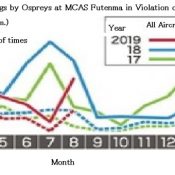
October 1, 2019 Ryukyu Shimpo
It has been seven years since the MV-22 vertical-takeoff-and-landing-capable (VTOL) transport aircraft was deployed to MCAS Futenma in Ginowan. As part of measures taken to reduce noise pollution from aircraft (the noise pollution prevention agreement), flights are restricted from 10:00 p.m. to 6:00 a.m. the following morning.
Since 2017, the proportion of Osprey takeoffs and landings in violation of this agreement among all such flights has been gradually increasing. When flying at low altitude, the Osprey can output noise pollution at levels that exceed the 100 decibels produced by jet engines, and this causes even greater distress for Okinawans when these flights occur at night.
According to observations that have been conducted the Okinawa Defense Bureau (ODB) since 2017, the total number of takeoffs and landings from MCAS Futenma in violation of the agreement was 569 in 2017, 618 in 2018, and 228 so far in 2019, measured from April through August.
Among these flights, Ospreys accounted for 170 in 2017, and 224 in 2018. For the same five-month period in 2019, Osprey flights have already reached half of the total 2018 figure at 111. As a percentage of the total violating flights, it has gradually risen from 29.9% in 2017 to 36.1% in 2018 and 48.7% for the flights that have been measured so far in 2019.
Most of the Osprey flights in violation of the agreement occur between 10:00 p.m. and midnight. The majority of noise complaints such as “being unable to sleep due to noise” filed to the city police base hotline come from these flights. The total number of Osprey takeoffs and landing was 2,300 in 2017, 2,952 in 2018, and 1,098 so far in 2019.
In July, when some CV-22 Ospreys from Yokota Air Base (Tokyo) came to Kadena for training, there were fears that the aircraft would come to MCAS Futenma for refueling, further exacerbating the burden on local residents. At Futenma, the Air Force can perform “Hot-Pit” refueling that can be done without stopping the engines, which is not possible at Kadena.
(English translation by T&CT and Sam Grieb)
Go To Japanese
Satoko Oka Norimatsu, Editor, The Asia-Pacific Journal: Japan Focus
This summer, I went to the Democratic People’s Republic of Korea, or in Japanese, Chosen Minshushugi Jinmin Kyowakoku (in short, “Chosen”), with three of my girlfriends.
Western media propagates this country as a “fearful dictatorship,” but what I saw, though it should come as no surprise, is a country where ordinary people work, go to school, play when they can, raise children, look after aging parents, and try to be good citizens.
When I recall my visit to Pyongyang, the scenery that comes up in my mind is a well-organized city rich with green, and the shiny surface of the Taedong River that runs through the city.
As we walked along the riverside one early morning, we saw people fishing and exercising, and I was reminded of a similar scene in my hometown of Vancouver, which is also a water-rich city.
The beer brand named after this river, “Taedonggang Beer,” is famous, and I enjoyed tasting not only their malt beer, but also their refreshing rice beer and smooth stout beer.
We were lucky in that the national holiday on August 15, “Homeland Liberation Memorial Day,” fell during our stay in the country.
We saw celebratory banners everywhere, and the supermarket we visited had a special “Liberation Day sale.”
Needless to say, “Homeland Liberation Day” is the day on which Korea was liberated from Japanese colonial rule in 1945.
The Korean Revolution Museum, which we had visited the previous day, remembers this history as “over 40 years of colonial rule,” counting from the 1905 “Eulsa Protection Treaty” by which Japan deprived Korea of its diplomatic authority.
There, late Chairman Kim Il-Sung, who is revered as the Founding Father of the country, is remembered as a hero who “defeated two empires in one generation,” as he fought in the 1930’s anti-Japan guerilla war through the frozen winters of Manchuria, and then repulsed the United States in the Korean War that erupted in 1950.
In the DPRK too, there are victims of forced mobilization, of Japanese military sex slavery, and of the atomic bombing of Hiroshima and Nagasaki.
Efforts to uncover the truth and secure compensation have been even more delayed than those in the South. There is the unresolved issue of stolen cultural assets as well.
In Kaesong, the ancient capital of the Koryo Kingdom, we visited the tomb of King Wanggon, designated as a World Heritage Site.
The guide there told us that cultural treasures in the tomb were stolen during the Japanese colonial period. I felt a pain in my chest.
At the Demilitarized Zone in Panmunjom, we saw up close the demarcation line which President Moon Jae-in, and then President Donald Trump, stepped across, both at the invitation of Chairman Kim Jong-Un, at the Inter-Korea Summit on April 27, last year and the Kim-Trump summit on June 30 of this year, respectively.
We heard from our local guides that 80% of foreign tourists to the DPRK are from China, and the rest are mostly from European countries.
On the day of our visit, the DMZ was swarming with international tourists, making it difficult for us to take photos.
Now that I have travelled to the DPRK, I strongly believe that it is wrong for Japanese people to call the DPRK “Kita-Chosen” (North Chosen) which is not the country’s proper name, while they call the southern state what it is, “Kankoku.”
The fact that Japanese people do not call the country by its proper name means that they do not recognize the DPRK as a country.
The DPRK has officially protested this form of address, and many Zainichi Koreans (Koreans in Japan), who have their ancestral roots in Korea, detest it too.
As soon as I set foot in Pyongyang this summer, my guides asked me to call their country by its full name, Chosen Minshushugi Jinmin Kyowakoku, or by its abbreviation, Chosen, not Kita-Chosen.
The name Kita-Chosen serves to deny the validity of the country as its own country, and is also reminiscent of how the Japanese called the northern part of the Korean peninsula “Hoku-Sen” (North Chosen) during the colonial period. For many, it is symbolic of Japanese colonialism against Koreans.
The ongoing negative campaign against the DPRK by the Japanese government and media contribute to the connotation of the word Kita-Chosen itself as something bad, something that most Japanese people almost automatically frown at as soon as they hear.
I believe that when one uses a certain name knowing that the addressee rejects it, one is committing an act of violence.
It is no different from the Japanese government bulldozing forward with the construction of the new Henoko base, knowing that the majority of Okinawans oppose it.
At the end of the visit, one of our guides, Mr. Kim, 27 years old, said to me, “I believe Korea is the only place in the world where one people (minjok) has been divided like this.”
His word weighed heavily on me, as a Japanese person, who shares responsibility for Korea’s division.
This is a modified English translation of No. 29 of the author’s series Norimatsu Satoko no me
[Norimatsu Satoko’s Eyes] that appeared on Page 3 of Ryukyu Shimpo, September 11, 2019 edition.
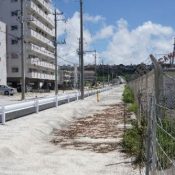
September 26, 2019 Ryukyu Shimpo
Saki Yoshida
Part of the work on Prefectural Route 24 Bypass, which is Okinawa is constructing to connect Chatan and Okinawa City, is being suspended as Okinawa has not received permission from the U.S. military for the work.
Part of the planned construction site runs through former a U.S. military installation, for which there is currently no plan to return to Japan.
Okinawa is asserting that they had the consent for construction from the U.S. military, however the military clarified, “In observance of the land return agreement,” and has denied Okinawa’s requests to enter the base area for measurements and a soil survey.
The Okinawa Defense Bureau (ODB), which is facilitating conversations between the two sides, has indicated that a third party is necessary for coordination before beginning construction, and the difference in understanding between each party has created confusion.
One person with knowledge of the situation commented, “A consensus was not built prior to the start of the project between all of the stakeholders, and has led to a muddled handling of the situation.”
Prefectural Route 24 Bypass is planned to run for 3,140 meters between the National Highway 58 Chatan Town Hall Entrance intersection and the Okinawa Loop road in Yamazato, Okinawa City.
Okinawa Prefecture has been constructing a 1,720 meter commercial road between Kuwae in Chatan and Minamitobaru in Okinawa City since 2003, after a decision by city planning in February, 2002.
This year, approximately 200 million was appropriated as a single year budget for this year.
The new bypass has a section that is set to run through Camp Kuwae (Camp Lester).
In May, 2018, Okinawa applied for permission from the U.S. military via the ODB, to conduct activities such as surveys and measurements on the target area, for which the return to Japan from the U.S. is scheduled to complete by 2025, after which construction can commence.
However, since part of the area where Okinawa is planning to build, the upper plaza of Camp Zukeran (Camp Foster), for which there currently is no plant to return, the U.S. military did not give Okinawa permission to enter.
A representative from the prefecture said, “If we cannot conduct the survey, it will be difficult to continue with work.”
Currently, I takes about 11 minutes to get from the Jagaru intersection to the Chatan Junior High School.
After the construction of the bypass it will take only five minutes to get from the Kuwae intersection to Chatan Junior High.
(English translation by T&CT and Sam Grieb)
Go To Japanese
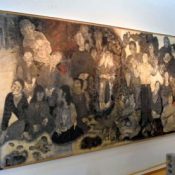
September 27, 2019 Ryukyu Shimpo
On September 25 an exhibition of all 14 panels of the Pictures of the Battle of Okinawa (Okinawasen no Zu) by the husband and wife artists, the late Iri and Shun Maruki, opened at the Sakima Art Museum (Director Michio Sakima).
This exhibit commemorates the 25th anniversary of the museum’s opening in 1994, and is the first time since the museum opened in 1994 that all panels of the work have been exhibited together. ]
The exhibit ends on December 16.
Although the series is known as the Pictures of the Battle of Okinawa, it does not only depict circumstances during the battle, it also includes many post-war and modern depictions.
The largest work and a number of the Pictures of the Battle of Okinawa are permanently on display, but other works in the series have been displayed in part.
The Marukis, known for The Hiroshima Panels (Genbaku no Zu), traveled to and from Okinawa between 1982 and 1987, and created the Pictures of the Battle of Okinawa by listening to the testimony of survivors of the Battle of Okinawa.
Director Sakima, who had a close relationship with the Marukis, said, “Maruki said that [the Pictures of the Battle of Okinawa] were created by everyone in Okinawa, together. There was a model for each person depicted, and [the work] was charged with the people’s sentiment that we must never make war again.”
Director Sakima called for people to attend the exhibition with the words: “Okinawans who still recall their experiences during this tragic land battle have said [the work] is extraordinary.
I want many Okinawans to please see and feel the realities in the images from the minds by which [the work] was created.”
(English translation by T&CT and Erin Jones)
Go To Japanese
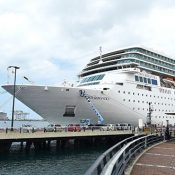
September 19, 2019 Ryukyu Shimpo
The “2019 Asia Cruise Forum Jeju,” an annual forum meant to stimulate the Asian cruise market, took place from August 28-30 on Jeju Island, Korea, where Okinawa was selected as the top port of call in Asia.
The number of ports, Okinawa’s nature and culture, superior geographic location, and speedy CIQ (Customs, Immigration, and Quarantine) process, among other factors contributed to their overall high rating.
This is the second time Okinawa has won the award since 2017.
The award ceremony was held August 28, and was attended by fumio Kijihana, head of the Okinawa Department of Culture, Tourism, and Sports’ Tourism Promotion office.
The Asia Cruise Forum Jeju gathers people from the cruise industry in the Asian region in order to exchange ideas and find areas of cooperation.
The goal is to grow the overall cruise market in Asia.
Kenichi Arakaki, head of the Okinawa Culture, Tourism, and Sports Department said, “We want to continue to work diligently at promoting cruises.”
(English translation by T&CT and Sam Grieb)
Go To Japanese
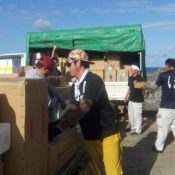
September 26, 2019 Ryukyu Shimpo
Junko Uechi
Kitadaito—The Daito, a passenger-cargo ship connecting Kitadaito island to Naha, resumed operations on September 25.
Its operation was suspended on September 11, due to stormy conditions and a typhoon passing by.
Many flights to the island were cancelled as well, causing a shortage of food items in Kitadaito Village.
Once the container ships reached Ezaki port in Minami, plenty of fresh foods, frozen items, and sundries were unloaded and transported to Kitadaito Village.
Workers from JA Okinawa Kitadaito and the local shops loaded their trucks at port.
At Miyagi Shoten, customers looking to purchase vegetables and bread waited patiently for the shelves to be re-stocked.
Inside the JA store, many customers smiled in relief as they stood in line to pay for their bread and frozen foods.
(English translation by T&CT and Monica Shingaki)
Go To Japanese
Satoko Oka Norimatsu, Editor, The Asia-Pacific Journal: Japan Focus
I am writing this in Hiroshima on August 6, on the 74th anniversary of the atomic bombing of the city.
For the last 13 years, I have participated in an annual peace study tour for U.S. and Japanese university students to Hiroshima and Nagasaki, and translated atomic bomb survivors’ stories.
What bothered me at this year’s Hiroshima Peace Memorial Ceremony was the repetition of the phrase yui-itsu (the only).
Hiroshima City’s mayor Matsui Kazumi and Prime Minister Abe Shinzo both stressed in their respective speeches that Japan was “the only a-bombed nation in war.”
Hiroshima Governor Yuzaki Hidehiko even went as far as to say “We, the Japanese, who are the only people who have experienced the horror of the atomic bomb.” It was outright “a-bomb nationalism.”
The word “yui-itsu” excludes hibakusha (a-bomb victims) who were not “Japanese,” particularly those from the Korean Peninsula, accounting for 10 percent or more of all hibakusha.
They were never mentioned in the ceremony.
Japan is in the middle of a Korea-bashing storm.
Since Korea’s Supreme Court’s ruling last fall ordering perpetrating companies to pay compensation to the victims of forced labour, the Japanese government has not only refused to sincerely observe the ruling, it has also raised its fist against the Korean government, and went as far as to levy economic sanctions against Korea.
The Japanese mainstream media is largely siding with the Japanese government, dragging public opinion along with it.
Amid such an atmosphere, even peace-friendly Hiroshima repeats the mantra of “Japan as the only a-bombed nation,” without giving any thought to the Korean hibakusha, who would not have been in Hiroshima to suffer the bombing if it were not for the Japanese colonization of Korea.
It is quite symbolic that a large rising-sun flag flies right beside the Cenotaph, the Memorial Monument for Hiroshima.
In late July, I visited Hapcheon, a place called “Korea’s Hiroshima,” with a friend.
Many people of Hapcheon, impoverished under the Japanese colonial rule, moved to Hiroshima for their livelihood, or by forceful mobilization, only to be further victimized in the atomic bombing of the city by the United States on August 6, 1945.
They had little access to health care, even less than Japanese hibakusha, because of the discrimination against Koreans.
Many could not disclose that they were hibakusha at all, for fear of stigma associated with being hibakusha. Poor health and poverty have been passed down through subsequent generations.
In Hapcheon, we spent a night hearing the life story of Han Jeongsun (born 1959) at the “House of Peace,” a facility established by a Buddhist organization to support second-generation hibakusha like Han.
“People say 1945 was a year of liberation. But to me, war started when I was born,” she said.
“I want to see Japan held responsible for treating Koreans like dogs, and the U.S. held responsible for using nuclear weapons against human beings.”
After Hapcheon, I visited the National Memorial Museum of Forced Mobilization Under Japanese Occupation in Busan.
Now more than ever, I think it is important for Japanese people to visit this museum and learn about the experiences of the over 7.8 million Koreans who were mobilized by force, “the total control of the human, material and financial resources by the Japanese Empire in order to wage a war in the Asia-Pacific,” as explained at the museum.
The museum exhibit included a screen showing approximately three hundred companies that used forced mobilization and still operate.
The list included the name of the company that my father worked for. In a diorama depicting Korean labourers working in the battlefield while watched by Japanese soldiers, there was a sign that said, “Koreans are not allowed to enter shelters during air raids.”
This reminded me of the diorama at the Okinawa Prefectural Peace Memorial Museum showing the inside of an evacuation cave where a frightened family tries to silence a baby while a Japanese soldier stands with his bayonet pointed towards the family.
In the Battle of Okinawa too, many Okinawans were driven from caves by the Japanese military only to die in the storm of shells and cannons in the battlefield.
August is when we remember the war. We should remember to do so in the shoes of those who were victimized by Japan.
This is an English translation of No. 28 of the author’s series Norimatsu Satoko no me [Norimatsu Satoko’s Eyes] that appeared on Page 3 of Ryukyu Shimpo, August 15, 2019 edition.











 Webcam(Kokusai Street)
Webcam(Kokusai Street)


